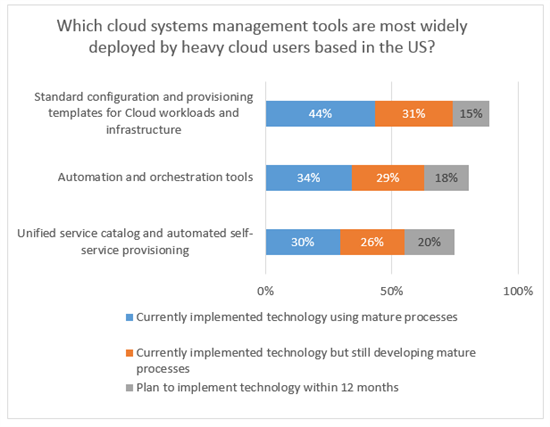Adapted from: Automated Infrastructure Management Powers Future-Ready Enterprise Clouds, by Mary Johnston Turner and Rick Villars, IDC #US41104316
Future-ready organizations react quickly to market changes and aggressively move to disrupt industries by harnessing the power of new technologies to launch digital business initiatives. Future-ready clouds enable digital strategies by providing flexible, on-demand access to required IT resources and services. Automated infrastructure management provides the control point for IT organizations to rapidly scale and expand hybrid cloud resources as needed to support emerging business and DevOps demands for greater capacity, broader geographic coverage, and improved flexibility.
Compared with traditional static client/server architectures built on dedicated physical or virtual servers, cloud architectures allow enterprises to spin up resources and shift workloads as needed to accommodate business priorities. Organizations achieve greater agility, flexibility, and data control at the application level and the business level than was possible previously. They also improve IT operational productivity and user (internal and external) satisfaction.
The most experienced users of future-ready clouds depend on open, extensible automated infrastructure management tools to support standardized service configuration templates, streamlined user request processes, collaborative governance models, and business-centric SLAs. These types of automated infrastructure management tools allow organizations to optimize the consumption of infrastructure resources and the performance needs of the applications. IT teams are also able to work much more efficiently and deliver more consistent user experiences across hybrid cloud environments.
IDC’s research shows that the most experienced cloud users have committed to using automation across their cloud management environments. Many feel they have already reached a state of full maturity in using these tools while others are still working to optimize policies, standards and workflows. Collectively, among heavy cloud users in the U.S., template-based configuration management tools are used by 74% of organizations, automation and orchestration tools have been implemented by 63%, and 55% use self-service provisioning automation and service catalogs.
n = 701, “heavy” U.S. cloud users defined as using cloud to support multiple production workloads
Source: IDC, CloudView 2016
IT organizations that are considering investing in modern automated infrastructure management solutions for hybrid cloud should focus on the following five factors to ensure that their cloud management strategy is future ready:
- Hybrid cloud support to ensure workload portability
- Open, extensible architecture
- API-based integrations across diverse infrastructure platforms and management tools
- Robust IT asset management and template design libraries
- Unified control across network, storage, and compute resources
The use of automated infrastructure management to ensure consistent allocation of resources for dynamic applications and digital transformation initiatives is critical for any IT organization that wants to maintain service levels and optimize costs across hybrid clouds. To learn more about how future-ready clouds are powered by automated infrastructure management solutions visit Future Ready Cloud.
